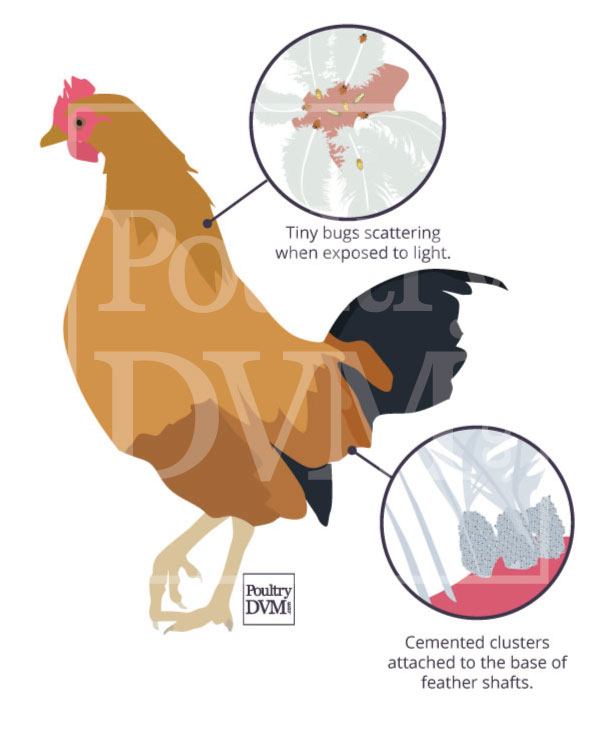Lice are the most common ectoparasite found in backyard and free-range flocks worldwide. They are small, flat, wingless six-legged parasites which are host-specific. Lice spend their entire life cycle on the chicken. During this time, they survive by eating feather parts, dead skin and blood. Chickens are normally relatively effective at keeping lice and other ectoparasites off of their bodies through dustbathing and preening (grooming) their feathers.
Lice become more of a problem when chickens aren't dustbathing or preening properly. If multiple birds are infested it is usually related to the environment and lack of an appropriate area to dustbathe. Usually, chickens will try to create their own dustbathing areas if given access to the ground. If it is frequently raining and/or drainage is poor this can have an impact.
When there is one or two chickens heavily infested with lice it is usually an indicator of an underlying health issue impacting their ability to effectively groom their feathers or make the proper movements necessary to dustbathe. Reasons for why an individual chicken may be more prone to heavy lice infestations include:
- Beak-related:Chickens who have had their beak trimmed, have a beak deformity, or beak injury will have a more difficult time preening their feathers.
- Mobility-related: Chickens with paralysis, arthritis, leg injuries, muscle weakness, certain leg deformities or neurological issues may not be able to dustbathe properly.
- Underlying illness: Chickens who aren't feeling well tend to spend less time dustbathing and grooming their feathers.
- Sex-related: Roosters tend to be targeted by lice more than hens.
Signs of Lice
Chickens who are mildly infested typically won't present with obvious behaviors that may suggest lice infestation. During heavy infestations they may:
- Scratch themselves more than usual.
- Have broken/damaged/missing feathers
- Appear restless
- Roosters may behave more aggressively or timid.
Each chicken should be examined regularly for ectoparasites. Conduct the examination somewhere with good lighting. Outside in direct sunlight is ideal.
While examining the bird, start at the area just above their vent and move throughout their body. Part through the feathers to expose the skin. Adult lice are large enough to be visible to the naked eye but can sometimes be difficult to see depending on the color contrast to the bird's feathers and skin. When certain species of lice are exposed to light they will scatter and hide. This movement will catch your eye. Others are slower moving. Look on both sides of the feathers.
During heavy infestations, you may also see cement-like clusters (of lice eggs) attached to the base of the chicken's feathers.
Common Types of Poultry Lice
There are several different species of lice which can infest chickens. They differ in body shape, color, and size. Each species has certain locations they prefer to inhabit on the chicken's body.
- Chicken Head Louse: As adults, Cuclotogaster heterographus are 2.5 mm long with oblong grayish bodies and triangular heads. They tend to live on the base of the feathers of the bird's head and neck.
- Fluff Louse: As adults, Goniocotes gallinae are 1.5 mm long with round, yellow bodies. They are found within the feather fluff along the bird's back, abdomen, and vent. Eggs are found in clusters near the base of feathers.
- Brown Chicken Louse: As adults, Goniodes dissimilis are 3.5 mm long with reddish brown bodies. They can be found throughout the chicken's body and live on the skin and feathers. Eggs are found in clusters near the base of feathers.
- Wing Louse: As adults, Lipeurus caponis are 2 m long with slender, grayish bodies. They are typically found on the bird's skin and undersides of the large wing and tail feathers. Eggs are found in clusters near the base of feathers.
- Chicken Body Louse: Menacanthus stramineus are one of the most common species of poultry lice found in backyard and free-range chickens worldwide. They are 3.5 mm long with yellow to brown colored bodies. This species live close to the skin and found around the bird's vent, breast, head, and underneath the wings. Eggs are found as cemented clusters along the base of feathers.
- Shaft Louse: Menopon gallinae are commonly found in backyard and free-range flocks worldwide. They are 2.3 mm long with pale yellow bodies. They live on the shafts of newly grown feathers along the bird's breast and thigh areas. Eggs are found cemented individually at the base of feather shafts or along feather barbs.

Lice have a life span of about a month. During that time, one female louse will lay from 50 to 300 eggs (referred to as "nits"). Lice eggs look like whitish, oval capsules which are cemented in clusters or individually to the base or barbs of the feathers. The eggs are often easier to find then the lice, since the eggs will glisten in reflected light, particularly before they hatch. Most lice eggs require 4 to 7 days to hatch and then 10 to 15 days to reach adulthood. Hatched eggs will remain attached to the feathers and appear grayish and flattened in appearance.
Not all members of the flock will necessarily have lice. However, the presence of some lice on most birds or of egg clusters attached to one or more birds is enough cause to assume that the entire flock has lice. Treatment involves removal of the eggs (if present) and application of an insecticide. Removal of the eggs is important because they are resistant to insecticides. If only a handful of feathers have eggs attached, it may be easier just to cut or pull off the feathers. Alternatively, coating them with a softening agent such as NuStock or similar product may help with manual removal. There are many commercial insecticide products available on the market for treatment of lice.
Make sure to read the product label to ensure that it specifically states its effectiveness against lice (as there are some products intended for mites and fleas only, and not effective for lice).

